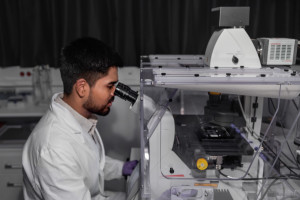This research programme focusses on analysing the molecular mechanisms associated with various illnesses, for example cardio-vascular diseases. Many diseases have multi-factorial causes – genetic constellations also play a part in addition to environmental and nutritional factors. Because the prognosis varies from patient to patient, they respond to treatment in different ways. In order to obtain a comprehensive understanding of the disease mechanisms and to diagnose the diseases earlier in future, and to be able to administer individual treatments more effectively and with fewer side effects, researchers at ISAS identify potential target molecules.

© ISAS / Hannes Woidich
The fundamental research conducted by the scientists involves using methods that are by no means restricted to genome level, but instead also use proteomic and metabolomic parameters. The researchers apply, test and optimise multi-omics methods for this purpose. One of the focal themes of the programme are cardiovascular diseases. Here, the institute has many years of analytical expertise to fall back on, including comprehensive investigations into the proteomes of thrombocytes (blood platelets) and also in-depth investigation of thrombocyte malfunctions and molecular processes in the event of cardiac insufficiency (commonly known as heart failure).
Molecular mechanisms of cardiac insufficiency
The molecular causes and the course of many diseases of the cardiovascular system are still largely not understood. The scientists at ISAS work on improving diagnostics for cardiac insufficiency and establishing new treatment approaches. They combine traditional molecular genetic and biochemical methods with high throughput methods. This enables them to cover the entire bandwidth of the analysis – from detailed investigation of individual components through to analysis of entire cellular systems.
Characteristic courses of disease & reduction of side effects
The scientists involved in this research programme develop new instruments for diagnosis and treatment which enables them to differentiate between different heart diseases. To achieve this, they work with transgenic mice, for example. The objective is to work out the spectroscopic characteristics of various courses of disease. The scientists have continued to press ahead intensively with biospectroscopy analyses, among other things, using vibration microscopy and high-resolution microscopy with imaging. Using the optical methods, in-vivo and molecular biological investigations, they have succeeded, in collaboration with Julius-Maximilians-Universität of Würzburg and the University of Duisburg-Essen, in investigating various molecular mechanisms of cardiac insufficiency in different mouse models with genetic diseases and detecting the disease in its early stages using the M. Fabry model, for example.
In order to identify the potential of non-linear spectroscopic imaging instruments and various assays for the identification of cardiac involvement in metabolic disorders and genetically-based storage diseases such as Fabry disease, the researchers use Coherent Anti-Stokes Raman Scattering (CARS) microscopy to carry out the investigation with the mouse model. Thanks to the high sensitivity of the acquired spectral information and the computer-assisted diagnostics, subtle changes in the protein-lipid content between the heart tissue in Fabry disease and control tissue can be detected with up to 96 percent reliability.
Furthermore, in this research programme the scientists develop and optimise silicon-based nanocontainers which means that drugs can be applied for heart muscle cells specifically, which reduces the side effects. The researchers are also investigating the action mechanism of Cold Atmospheric Plasma (CAP) in the treatment of cardiovascular diseases. Until now, this kind of plasma has mainly been used in the area of tissue repair, for treating infectious skin disease, in dentistry and for cancer treatment. These plasma could increase the concentration of nitrite in the blood and therefore reduce a cardiovascular risk factor.